The "error", I* believe, is that you forgot about the MOSFETs's parasitic diode, which won't let you do what you want even if the "inactive" transistors are turned OFF.
For example, below, if Q1 is turned OFF and Q2 is turned ON, D1 will be forward biased and will connect V3 to V1 as well as to R1.
However, if Q1 is turned ON and Q2 is turned OFF, D2 will be reverse biased by V3, so that'll work.
I don't think the scheme will work, in general, since there'll always be one diode forward biased unless the only thing ON is the transistor switching the lowest voltage supply.
By the way, I've posted the LTspice circuit list after the grasphic just in case you want to play with the circuit.

Version 4
SHEET 1 880 680
WIRE 128 -32 80 -32
WIRE 240 -32 192 -32
WIRE 80 64 80 -32
WIRE 80 64 -176 64
WIRE 112 64 80 64
WIRE 240 64 240 -32
WIRE 240 64 208 64
WIRE 336 64 240 64
WIRE 128 112 -64 112
WIRE 128 208 80 208
WIRE 240 208 192 208
WIRE 80 304 80 208
WIRE 80 304 32 304
WIRE 112 304 80 304
WIRE 240 304 240 208
WIRE 240 304 208 304
WIRE 336 304 336 64
WIRE 336 304 240 304
WIRE 336 384 336 304
WIRE -176 400 -176 64
WIRE -64 400 -64 112
WIRE 32 400 32 304
WIRE 128 400 128 352
WIRE -176 544 -176 480
WIRE -64 544 -64 480
WIRE -64 544 -176 544
WIRE 32 544 32 480
WIRE 32 544 -64 544
WIRE 128 544 128 480
WIRE 128 544 32 544
WIRE 336 544 336 464
WIRE 336 544 128 544
WIRE -176 592 -176 544
FLAG -176 592 0
SYMBOL pmos 208 112 M270
WINDOW 0 94 64 VLeft 2
WINDOW 3 69 98 VLeft 2
SYMATTR InstName Q1
SYMATTR Value Si7137DP
SYMBOL pmos 208 352 M270
WINDOW 0 93 64 VLeft 2
WINDOW 3 66 104 VLeft 2
SYMATTR InstName Q2
SYMATTR Value Si7137DP
SYMBOL res 320 368 R0
SYMATTR InstName R1
SYMATTR Value 1
SYMBOL voltage 32 384 R0
WINDOW 123 0 0 Left 2
WINDOW 39 0 0 Left 2
SYMATTR InstName V3
SYMATTR Value 5
SYMBOL voltage -176 384 R0
WINDOW 123 0 0 Left 2
WINDOW 39 0 0 Left 2
SYMATTR InstName V1
SYMATTR Value 3.3
SYMBOL voltage -64 384 R0
WINDOW 3 24 96 Invisible 2
WINDOW 123 0 0 Left 2
WINDOW 39 0 0 Left 2
SYMATTR Value PULSE(10 0 1 1u 1u 1)
SYMATTR InstName V2
SYMBOL voltage 128 384 R0
WINDOW 3 24 96 Invisible 2
WINDOW 123 0 0 Left 2
WINDOW 39 0 0 Left 2
SYMATTR Value PULSE(10 0 3 1u 1u 1)
SYMATTR InstName V4
SYMBOL diode 192 -48 R90
WINDOW 0 -29 31 VBottom 2
WINDOW 3 -31 29 VTop 2
SYMATTR InstName D1
SYMATTR Value RFN30TS6D
SYMBOL diode 192 192 R90
WINDOW 0 -32 30 VBottom 2
WINDOW 3 -32 30 VTop 2
SYMATTR InstName D2
SYMATTR Value RFN30TS6D
TEXT -168 568 Left 2 !.tran 5


